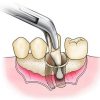Success in clinical dentistry requires a thorough understanding of the anatomic and biologic nature of the tooth, with its components of enamel, dentin, pulp, and cementum, as well as the supporting tissues of bone and gingiva. Dentistry that violates the physical, chemical and biologic parameters of tooth tissues can lead to premature restorative failure, compromised coronal integrity, recurrent caries, patient discomfort, or even pulpal necrosis. It is only within a biologic framework that the materials, principles, and techniques that constitute operative dentistry are validated.

Excellence in dental care is achieved through the dentist’s ability to assess the patient, determine his or her needs, design an appropriate plan of treatment, and execute the project with proficiency. Inadequately planned surgery, even when well-executed, will result in less-than-ideal care. The process of identifying problems and designing the treatment for those problems is the essence of treatment planning.
As an integral part of comprehensive dental care, treatment planning for the restoration of individual teeth must be done in concert with the diagnosis of problems and treatment planning for the entire masticatory system. This approach begins with comprehensive patient evaluation, and grade ally narrows its focus to the restoration of individual teeth. Emphasis is placed on the decision-making processes involved in identifying problems related to restorative dentistry, assessing the demands of the oral environment, and selecting the materials and operative modalities best suited to the treatment of these problems.
Examination
For restorative treatment planning, the intraoral assessment involves an examination of the periodontium, dentition, and occlusion. Specific diagnostic tests may be performed as indicated, and a radiographic exam is completed. Each portion of the evaluation should be completed before another aspect of the examination is begun.
The findings from each area are placed under the appropriate heading in the problem list. Duplication is common because some problems are noted in the evaluation of more than one system. For example, gingival bleeding and periodontal inflammation resulting from a restoration impingement on the periodontal attachment would be noted in both the periodontal examination and the evaluation of the existing restorations. At this stage, such duplication of effort is acceptable in the interest of completeness.
Planning
Treatment planning is generally accomplished with either a treatment-oriented model or a problem-oriented model. In the treatment-oriented model, the dentist examining the patient finds certain intraoral conditions and mentally equates those problems to the need for certain forms of treatment. The examination findings are summarized in the form of a list of needed medications, which then becomes the treatment plan.
The problem-oriented model requires that the examination leads to the formulation of a list of problems. Each problem on the list is then considered in terms of treatment options, each of which has different advantages and disadvantages. The optimal solution for each issue is then chosen, and after sequencing, this list of solutions becomes the treatment plan. For patients with only a few, uncomplicated problems, the outcomes are similar, whether the treatment plan is problem-based or treatment based.
In more complex cases, issues are often interrelated, and the solution to one problem may affect the treatment needed to resolve other issues. In these instances, the process of identifying and listing the individual problems enables the dentist to think through each problem and consider the treatment options without getting lost in the magnitude of the overall task.
Process
The treatment planning process includes the following steps: A thorough evaluation of the stomatognathic system is completed, problems requiring treatment are identified, and an integrated treatment plan is designed. Given all of the issues, the clinician visualizes the state of the dentition after the anticipated removal of severely compromised and nonrestorable teeth.
Having pictured the remaining sound dentition, the dentist visualizes the optimal state to which the patient’s dentition can be restored. The clinician then details the treatments needed to achieve this optimal result. The process of “planning in reverse,” starting with the result in mind, often enables the clinician to identify previously unforeseen problems and add them to the problem list.
The orthograde plan (planning treatment based on existing problems) and the retro-grade plan (planning in reverse, starting from the desired result) are combined and then coordinated such that the treatment for each problem on the problem list is consistent with the desired optimal treatment goal. This list of treatment steps is then sequenced.
Treatment Plan
Having completed a comprehensive examination, the dentist lists problems related to restorative dentistry on the medicinal dentistry problem list.
Each of the issues on the problem list is then reevaluated. After consideration, some of the problems may be deleted from the list. For example, a tooth with a defective restoration may also have a significant loss of periodontal attachment and, therefore, a poor periodontal prognosis. In such a case, the broken repair is initially considered a problem, but, given the periodontal condition, the tooth would be planned for extraction rather than repair.
The defective restoration is then omitted from the restorative problem list. Once the final problem list is formulated, the next step is to establish a plan for the treatment of each problem on the list.
A problem list worksheet is a useful tool to help organize the planning of treatment for each problem. It consists of an unsequenced list of the issues and their associated solutions. Later, during the sequencing process, this list of medications will be integrated into the comprehensive treatment plan. Planning the restoration of individual teeth is the “nuts and bolts” of restorative dentistry treatment planning. It requires the consideration of four primary factors as well as several modifying factors.
The primary considerations are:
(1) the amount and form of the remaining tooth structure;
(2) the functional needs of each tooth;
(3) the esthetic demands of each tooth; and
(4) the final objective of the overall treatment plan.

